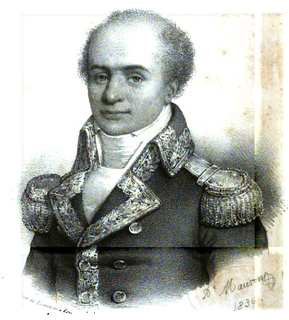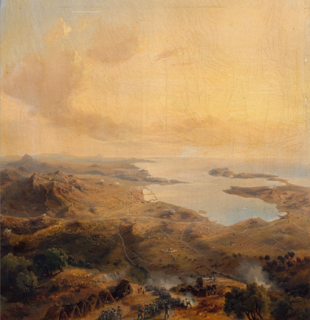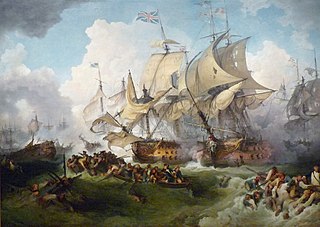HMS Berwick was a 74-gun Elizabeth-class third rate of the Royal Navy, launched at Portsmouth Dockyard on 18 April 1775, to a design by Sir Thomas Slade. She fought the French at the Battle of Ushant (1778) and the Dutch at the Battle of Dogger Bank (1781). The French captured her in the Action of 8 March 1795 during the French Revolutionary Wars and she served with them with some success then and at the start of the Napoleonic Wars until the British recaptured her at the Battle of Trafalgar. Berwick sank shortly thereafter in a storm.

The Battle of Genoa was a naval battle fought between French and allied Anglo-Neapolitan forces on 14 March 1795 in the Gulf of Genoa, a large bay in the Ligurian Sea off the coast of the Republic of Genoa, during the French Revolutionary Wars. The French fleet was led by Contre-amiral Pierre Martin and comprised 14 ships of the line while the British Royal Navy and Neapolitan fleet, under Vice-Admiral William Hotham mustered 13 ships of the line. The battle ended with a minor British-Neapolitan victory and the capture of two French ships.
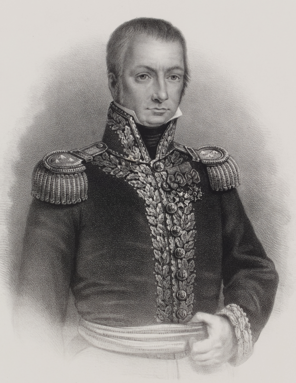
Amable Gilles Troude was a French Navy officer, hero of the Napoleonic Wars.

The Atlantic campaign of 1806 was one of the most important and complex naval campaigns of the post-Trafalgar Napoleonic Wars. Seeking to take advantage of the withdrawal of British forces from the Atlantic in the aftermath of the Battle of Trafalgar, Emperor Napoleon ordered two battle squadrons to sea from the fleet stationed at Brest, during December 1805. Escaping deep into the Atlantic, these squadrons succeeded in disrupting British convoys, evading pursuit by British battle squadrons and reinforcing the French garrison at Santo Domingo. The period of French success was brief: on 6 February 1806 one of the squadrons, under Vice-Admiral Corentin Urbain Leissègues, was intercepted by a British squadron at the Battle of San Domingo and destroyed, losing all five of its ships of the line.

The Atlantic campaign of 1806 was a complicated series of manoeuvrees and counter-manoeuveres conducted by squadrons of the French Navy and the British Royal Navy across the Atlantic Ocean during the spring and summer of 1806, as part of the Napoleonic Wars. The campaign followed directly from the Trafalgar campaign of the year before, in which the French Mediterranean fleet had crossed the Atlantic, returned to Europe and joined with the Spanish fleet. On 21 October 1805, this combined force was destroyed by a British fleet under Lord Nelson at the Battle of Trafalgar, although the campaign did not end until the Battle of Cape Ortegal on 4 November 1805. Believing that the French Navy would not be capable of organised resistance at sea during the winter, the First Lord of the Admiralty Lord Barham withdrew the British blockade squadrons to harbour. Barham had miscalculated – the French Atlantic fleet, based at Brest, had not been involved in the Trafalgar campaign and was therefore at full strength. Taking advantage of the reduction in the British forces off the port, Napoleon ordered two heavy squadrons to sea, under instructions to raid British trade routes while avoiding contact with equivalent Royal Navy forces.
Lamellerie's expedition was a French naval operation launched in February 1806. Four French Navy frigates and a brig, all survivors of the Battle of Trafalgar in October 1805, attempted to break past the British blockade of Cadiz on 23 February 1806, taking advantage of the withdrawal of the principal blockade squadron several months earlier at the start of the Atlantic campaign of 1806. Although the squadron was intercepted by elements of the British blockade force, Captain Louis-Charles-Auguste Delamarre de Lamellerie escaped with the four frigates by abandoning the slower brig, which was captured. During the next six months, Lamellerie's squadron cruised the Atlantic, visiting Senegal, Cayenne and the West Indies but failing to cause any significant disruption to British trade.
L'Hermite's expedition was a French naval operation launched in 1805 during the Napoleonic Wars. The operation was intended as both a commerce raiding operation against the British trading posts of West Africa and as a diversion to the Trafalgar campaign. Sailing from Lorient in October 1805 with one ship of the line, two frigates and a corvette, Commodore Jean-Marthe-Adrien L'Hermite was under orders to intercept and destroy British traders and slave ships off the West African coast and await reinforcements under Jérôme Bonaparte which were to be used in the invasion and capture of one of the British trading forts for use as a permanent French naval base from which further raiding operations could be conducted. It was also hoped by the French naval command that L'Hermite might draw some of the large British fleet maintained off Cadiz away from the blockade to allow the French and Spanish allied fleet trapped in the harbour to escape.

Allemand's expedition of 1805, often referred to as the Escadre invisible in French sources, was an important French naval expedition during the Napoleonic Wars, which formed a major diversion to the ongoing Trafalgar Campaign in the Atlantic Ocean. With the French Mediterranean Fleet at sea, Emperor Napoleon I hoped to unite it with the French Atlantic Fleet and together form a force powerful enough to temporarily displace the British Royal Navy Channel Fleet for long enough to allow an invasion force to cross the English Channel and land in Britain. In support of this plan, the French squadron based at Rochefort put to sea in July 1805, initially with the intention that they would join the Atlantic Fleet from Brest. When this fleet failed to put to sea, the Rochefort squadron, under Contre-Admiral Zacharie Allemand, went on an extended raiding cruise across the Atlantic, both to intercept British trade left lightly defended by the concentration of British forces in European waters and with the intention of eventually combining with the French Mediterranean Fleet then blockaded in Spanish harbours.

The Battle of Les Sables-d'Olonne was a minor naval battle fought on 23 February 1809 off the town of Les Sables-d'Olonne on the Biscay Coast of France between a French Navy squadron of three frigates and a larger British squadron of ships of the line. The French squadron had sailed from the port of Lorient on 23 February in an effort to link up with a fleet from Brest under Jean-Baptiste Willaumez, but missed the rendezvous and was pursued by a British blockade squadron under Rear-Admiral Robert Stopford. The French commander, Commodore Pierre Roch Jurien, anchored his squadron under the batteries which protected the town of Les Sables-d'Olonne in the hope of dissuading an attack.

The Action of 15 July 1798 was a minor naval battle of the French Revolutionary Wars, fought off the Spanish Mediterranean coast by the Royal Navy ship of the line HMS Lion under Captain Manley Dixon and a squadron of four Spanish Navy frigates under Commodore Don Felix O'Neil. Lion was one of several ships sent into the Western Mediterranean by Vice-Admiral Earl St Vincent, commander of the British Mediterranean Fleet based at the Tagus in Portugal during the late spring of 1798. The Spanish squadron was a raiding force that had sailed from Cartagena in Murcia seven days earlier, and was intercepted while returning to its base after an unsuccessful cruise. Although together the Spanish vessels outweighed the British ship, individually they were weaker and Commodore O'Neil failed to ensure that his manoeuvrees were co-ordinated. As a result, one of the frigates, Santa Dorotea, fell out of the line of battle and was attacked by Lion.
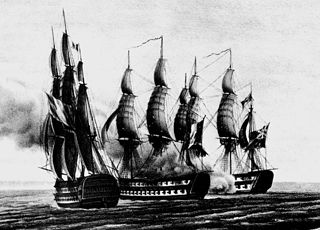
Ganteaume's expeditions of 1801 were three connected major French Navy operations of the spring of 1801 during the French Revolutionary Wars. A French naval squadron from Brest under Contre-amiral Honoré Ganteaume, seeking to reinforce the besieged French garrison in Egypt, made three separate but futile efforts to reach the Eastern Mediterranean. The French army in Egypt had been trapped there shortly after the start of the Napoleonic campaign in Egypt in 1798, when the French Mediterranean Fleet was destroyed at the Battle of the Nile. Since that defeat, the French Navy had maintained only a minimal presence in the Mediterranean Sea, while the more numerous British and their allies had succeeded in blockading and defeating several French bases almost unopposed.

The Algeciras campaign was an attempt by a French naval squadron from Toulon under Contre-Admiral Charles Linois to join a French and Spanish fleet at Cadiz during June and July 1801 during the French Revolutionary War prior to a planned operation against either Egypt or Portugal. To reach Cadiz, the French squadron had to pass the British naval base at Gibraltar, which housed the squadron tasked with blockading the Spanish port. The British squadron was commanded by Rear-Admiral Sir James Saumarez. After a successful voyage between Toulon and Gibraltar, in which a number of British vessels were captured, the squadron anchored at Algeciras, a fortified port city within sight of Gibraltar across Gibraltar Bay. On 6 July 1801, Saumarez attacked the anchored squadron, in the First Battle of Algeciras. Although severe damage was inflicted on all three French ships of the line, none could be successfully captured and the British were forced to withdraw without HMS Hannibal, which had grounded and was subsequently seized by the French.
Allemand's escape from Lorient was an episode of the naval operations of the French Navy in 1812. A number of French, warships trapped in Lorient by the British blockade, managed to take to the sea under Zacharie Allemand and sail to Brest. British squadrons sailed in pursuit, but were unable to force the French fleet into action.
The Croisière de Bruix was the principal naval campaign of the year 1799 during the French Revolutionary Wars. The expedition began in April 1799 when the bulk of the French Atlantic Fleet under Vice-Admiral Étienne Eustache Bruix departed the base at Brest, evading the British Channel Fleet which was blockading the port and tricking the commander Admiral Lord Bridport into believing their true destination was Ireland. Passing southwards, the French fleet narrowly missed joining with an allied Spanish Navy squadron at Ferrol and was prevented by an easterly gale from uniting with the main Spanish fleet at Cádiz before entering the Mediterranean Sea. The Mediterranean was under British control following the destruction of the French Mediterranean Fleet at the Battle of the Nile in August 1798, and a British fleet nominally under Admiral Earl St Vincent was stationed there. Due however to St. Vincent's ill-health, operational control rested with Vice-Admiral Lord Keith. As Keith sought to chase down the French, the Spanish fleet followed Bruix into the Mediterranean before being badly damaged in a gale and sheltering in Cartagena.
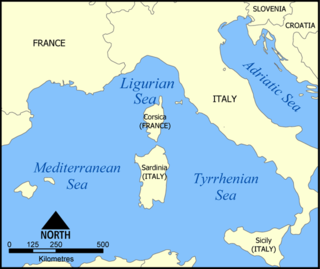
The Battle of the Hyères Islands was a naval engagement fought between a combined British and Neapolitan fleet and the French Mediterranean Fleet on 13 July 1795 during the French Revolutionary Wars. Since the start of the war in 1793 the French fleet had suffered a series of damaging defeats and was restricted to limited operations off the French Mediterranean Coast in the face of a determined allied blockade. The French fleet, commanded by Pierre Martin, had sought to test the blockade during 1795, and in March had been caught by the British, under William Hotham, in the Gulf of Genoa. At the ensuing Battle of Genoa two French ships were captured before Martin was able to retreat to a safe anchorage.

The Mediterranean campaign of 1793–1796 was a major theater of conflict in the early years of the French Revolutionary Wars. Fought during the War of the First Coalition, the campaign was primarily contested in the Western Mediterranean between the French Navy's Mediterranean Fleet, based at Toulon in Southern France, and the British Royal Navy's Mediterranean Fleet, supported by the Spanish Navy and the smaller navies of several Italian states. Major fighting was concentrated in the Ligurian Sea, and focused on British maintenance of and French resistance to a British close blockade of the French Mediterranean coast. Additional conflict spread along Mediterranean trade routes, contested by individual warships and small squadrons.
The Battle of the Levant Convoy was a naval engagement of the French Revolutionary Wars fought on 7 October 1795. During the battle, a powerful French squadron surprised a valuable British convoy from the Levant off Cape St Vincent on the coast of Portugal. The convoy was weakly defended, and although the small escort squadron tried to drive the French back, they were outmatched. In the ensuing action one of the British ships of the line and almost the entire convoy was overrun and captured. The French commander, Commodore Joseph de Richery, then retired to the neutral Spanish port of Cádiz, where he came under blockade.

Martin's cruise of 1794 was the only significant French naval operation of the year in the Mediterranean Sea. In 1793 France had gone to war with Great Britain and a wide coalition of European enemies in the French Revolutionary Wars. Early in the conflict the British had seized the French Mediterranean Fleet and their home port of Toulon, the town enduring a four month siege by French Republican forces in which the fleet was badly damaged. With the town and fleet back in French hands, the French set about effecting repairs as the British attacked the island of Corsica.
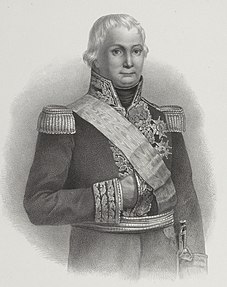
Ganteaume's expedition of 1795 was a French naval operation in the Aegean Sea in the autumn of 1795 during the French Revolutionary Wars. Commanded by Commodore Honoré Ganteaume in the ship of the line Républicain, with a squadron of four frigates and two corvettes, the French force was ordered to attack First Coalition shipping in the Aegean Sea. The principal target was the Ottoman city of Smyrna, the most significant trading port of the region, Ganteaume ordered to prey on merchant shipping sailing for European destinations and in particular a large convoy due to sail to Britain.


